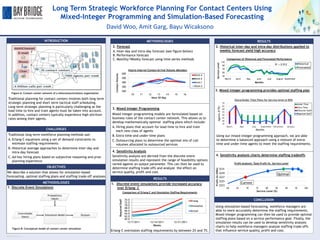Weitere ähnliche Inhalte
Ähnlich wie informs_poster (20)
informs_poster
- 1. RESEARCH POSTER PRESENTATION DESIGN © 2011
www.PosterPresentations.com
Using simulation-based forecasting, workforce managers are able to more accurately determine the staffing requirements. Mixed integer programming can then be used to provide optimal staffing plans based on a service performance goal. Finally, the simulation results can be used to develop sensitivity analysis charts to help workforce managers analyze staffing trade-offs that influence service quality, profit and cost.
Traditional planning for contact centers involves both long term strategic planning and short term tactical staff scheduling. Long term strategic planning is particularly challenging as the lead time to hire and train agents must be taken into account. In addition, contact centers typically experience high attrition rates among their agents.
INTRODUCTION
OBJECTIVES
Traditional long-term workforce planning methods use:
A.Erlang-C equations using a set of demand constraints to estimate staffing requirements
B.Historical average approaches to determine inter-day and intra-day forecast
C.Ad-hoc hiring plans based on subjective reasoning and prior planning experience
CHALLENGES
We describe a solution that allows for simulation-based forecasting, optimal staffing plans and staffing trade-off analyses
1. Discrete Event Simulations
2. Forecast
A.Inter-day and intra-day forecast (see figure below)
B.Performance forecast
C.Monthly/Weekly forecast using time-series methods
3. Mixed Integer Programming
Mixed integer programming models are formulated based on business rules of the contact center network. This allows us to develop mathematically optimal staffing plans which include:
A.Hiring plans that account for lead time to hire and train each new class of agents
B.Extra-time and under-time plans
C.Outsourcing plans to determine the optimal mix of call volumes allocated to outsourced services
METHODOLOGIES
4. Sensitivity Analysis
Sensitivity analysis are derived from the discrete event simulation results and represent the range of feasibility options varied against an output parameter. This can then be used to determine staffing trade-offs and analyze the effect on service quality, profit and cost.
200
300
400
500
600
10
11
12
13
14
15
16
Contact Volume
Hour Of Day
Hourly Interval Contact Arrival Volume (Monday)
Week A
Week B
Week C
Week D
Figure B: Conceptual model of contact center simulation
RESULTS
4. Sensitivity analysis charts determine staffing tradeoffs
60.0
62.0
64.0
66.0
68.0
70.0
72.0
74.0
12/7/2011
12/14/2011
12/21/2011
Required Staff
Weeks
Comparison of Erlang-C and Simulation Staffing Requirements
Erlang
Simulation
Actual
1.Discrete event simulations provide increased accuracy over Erlang- C
Erlang-C overstates staffing requirements by between 2% and 7%.
2. Historical inter-day and intra-day distributions applied to
weekly forecast yield high accuracy
3. Mixed integer programming provides optimal staffing plan
30
50
70
90
110
March
April
May
June
July
August
September
Service Level
Months
Comparison of Historical and Forecasted Performance
Historical
Forecasted
$223
$225
$227
$229
$231
60
65
70
75
80
85
90
95
100
Profit (in 000s)
Service Level (%)
Profit Analysis: Total Profit Vs. Service Level
Current
CONCLUSION
Figure A: Contact center network of a telecommunications organization
R² = 0.912
METHODOLOGIES
RESULTS
Using our mixed-integer programming approach, we are able to determine a balanced approach using a mixture of extra- time and under-time agents to meet the staffing requirements.
Optimal
35
40
45
50
55
60
65
70
March
May
July
September
November
January
Agents (FTE)
Months
Extra/Under Time Plans for Service level of 80%
Under Time
Extra Time
Effective Staff
Required Staff
David Woo, Amit Garg, Bayu Wicaksono
Long Term Strategic Workforce Planning For Contact Centers Using Mixed-Integer Programming and Simulation-Based Forecasting

